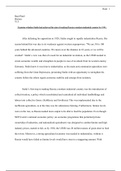Raul 1
Raul Patel
History
Y13
Examine whether Stalin had achieved his aim of making Russia a modern industrial country by 1941.
After defeating his opposition in 1928, Stalin sought to rapidly industrialise Russia. His
reason behind this was due to its weakness against western superpowers. “We are 50 to 100
years behind the advanced countries. We must cover the distance in 10 years, or we will be
crushed”. Stalin’s view was that of a need for an industrial revolution, as the USSR needed to
create economic wealth, and strengthen its people in case of an attack from its western enemy;
Germany. Stalin knew it was time to industrialise, as his main anti-communist opposition were
suffering from the Great Depression, presenting Stalin with an opportunity to strengthen his
country before the others regain economic stability and emerge from isolation.
Stalin’s first step to making Russia a modern industrial country was his introduction of
collectivisation; a policy which consolidated and centralised all individual landholdings and
labour into collective farms. (Kolkhozy and Sovkhozy) This was implemented due to the
inefficient agriculture, as at the time was for subsistence farming. Furthermore; famine levels
were on the rise, as Russia needed more output to be able to feed the population. Even though
NEP (Lenin’s national economic policy; an economic programme that permitted private
ownership of industries, and nationalised agriculture) was designed to combat famine and high
industry prices, started to fail, as by 1928, the USSR was 20 million tonnes of grain short to feed
the towns. Moreover, a strong agricultural economy was needed to industrialise, without it
Russia would have failed as famine levels would have risen to a staggering amount. With





